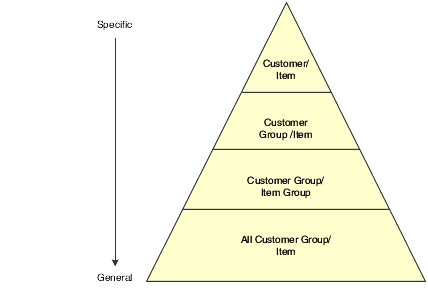Pricing Hierarchy
When the system retrieves the base price, it uses the hierarchy that you set up for the Base Price Preference (51) to determine the sequence with which it searches base price records. The base price hierarchy is a matrix comprising combinations of customers, items, customer price groups, and item price groups. You use the intersection of the rows and columns to determine the sequence with which the system retrieves the base price.
You should set up the pricing hierarchy from most specific pricing to most general pricing. The system searches for prices based on the hierarchy sequence. When the system finds a match for a price at an intersection, it stops searching the hierarchy. Therefore, if the most general pricing rule is set at sequence 1, the system does not find the customer or item specific pricing.
This example illustrates a most specific item and customer pricing hierarchy:

You can enter up to 14 numbers in the preference hierarchy. However, you should limit the hierarchy to as few numbers as necessary. Each number represents a search by the system through the Item Base Price File table (F4106). Therefore, each number that you add to the hierarchy increases the system processing time.